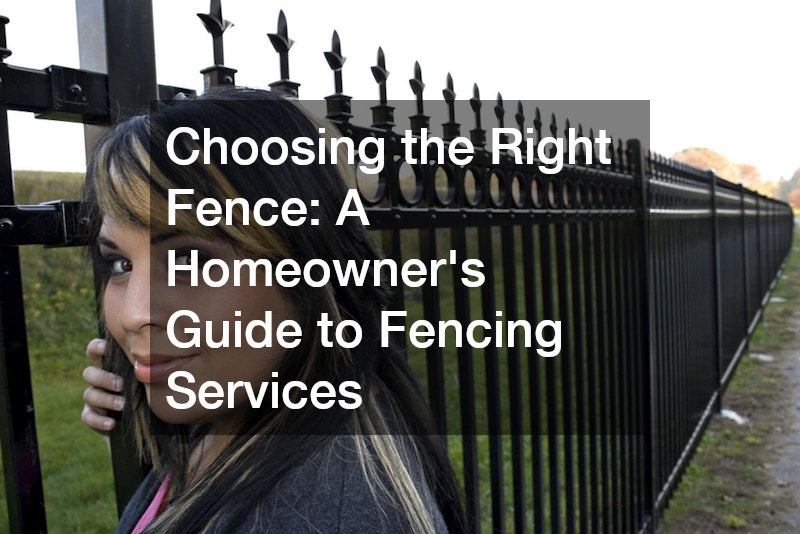Fencing services are an essential aspect of homeownership, providing a blend of privacy, security, and aesthetic appeal. Choosing the right type of fence is crucial as it impacts not only the look of your property but also its functionality. This guide will delve into the various fencing options available to homeowners and the factors to consider for optimal choice and installation.
1. What are the Different Types of Fences Available?
Wood fences are a classic choice among homeowners, offering a natural and timeless aesthetic. They are often favored for their versatility in design, allowing for personalized touches in staining or painting.
However, wood fences require regular maintenance to prevent rot and weather damage, which can add to the overall cost over time.
The benefits of wood fences include their ability to fit any architectural style and blend seamlessly with surrounding landscaping. Despite their charm, they are susceptible to damage from insects and moisture, which can lead to frequent repairs. When considering wood as a fencing material, homeowners must weigh the initial cost against long-term maintenance expenses.
For those looking to add value and curb appeal to their property, wood fences are an attractive option. While they typically require more upkeep than other materials, their unique charm can enhance any landscape. Ultimately, the decision to use wood should be based on a homeowner’s willingness to invest time and resources into regular upkeep.
Vinyl fences are known for their durability and low maintenance requirements, making them a popular choice. Unlike wood, vinyl does not rot, warp, or succumb to pest damage, providing longevity with minimal care. These fences come in a variety of styles and colors, allowing homeowners to find an option that matches their property’s aesthetic.
One of the most significant advantages of vinyl is its resistance to the elements and easy cleaning process. Though the initial cost can be higher than wood, the reduced need for maintenance often results in long-term savings. Vinyl fences are particularly appealing to those seeking a no-fuss, resilient option that stands the test of time.
For environmentally conscious homeowners, some vinyl fences are manufactured from recycled materials, making them an eco-friendly choice. The combination of aesthetic flexibility, durability, and ease of maintenance makes vinyl an attractive alternative for many homeowners. However, it’s crucial to ensure high-quality installation to prevent issues down the line.
2. How to Choose the Right Fence for Your Property?
Before selecting a fence, it’s crucial to determine its primary purpose, whether it be for privacy, security, decoration, or marking boundaries. Understanding what you hope to achieve with your fence can significantly narrow down the material and style choices. Consider how each type of fence will fulfill your specific requirements while complementing your property.
For instance, if privacy is the primary concern, tall, solid wood or vinyl fences are typically best. On the other hand, those prioritizing security might opt for robust metal options. It’s important to align your needs with the benefits of each fencing type to make the most informed decision.
Beyond functional needs, aesthetics play a pivotal role in fence selection. A well-chosen fence can enhance your property’s charm, while the wrong choice can detract from it. Recognizing the dual importance of utility and appearance will help ensure you choose the right fence for your home.
3. What to Expect During Installation?
When it comes to fence installation, homeowners must decide between hiring a professional service or undertaking the task themselves. Professional installers bring expertise, efficiency, and often offer warranties on labor and materials, providing peace of mind.
The choice between professional and DIY depends on factors such as budget, time, and personal capability. While DIY projects can be rewarding and save money, they may also lead to errors that professionals could avoid. Consider the complexity of the fence and your comfort level with the installation process when making this decision.
Ultimately, the route you choose should align with your project goals and constraints. Each option has its advantages and trade-offs, so it’s crucial to evaluate them based on your specific situation. Whether opting for professional services or a DIY approach, successful installation can enhance your property’s security and aesthetic value.
Choosing the right fence involves a multifaceted decision-making process that includes understanding different materials, evaluating needs, considering budget, and adhering to local regulations. This guide has explored these aspects, highlighting the importance of making informed choices to ensure a successful and satisfying result. With proper planning and maintenance, fences not only enhance property value but also provide privacy, security, and beauty to any home.

